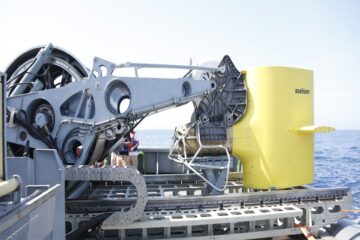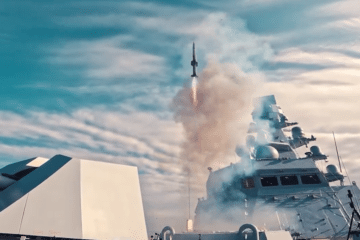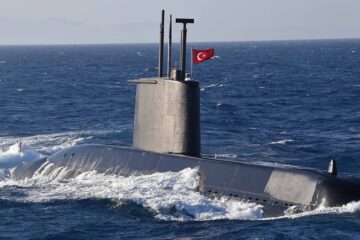The Turkish Ministry of Defense showcased a scale model of the future destroyer, which depicted the most recent developments in the project’s ongoing construction. The tonnage of the destroyer is the most notable difference in the concept model. According to the information label on the mock-up, the tonnage, which had previously been announced as 7,000 tons, has been increased to 8,500 tons.
The NAZAR Laser Electronic Attack System and the GEZGIN cruise missile are the two new additions to the ship’s weapon and sensor systems that catch the eye at first glance in the recent update.

An infographic of the TF-2000 ADD. Virtually all systems will be sourced and designed locally. (Source: Turkish Naval Forces)
At the IDEF-21 exhibition, two significant advancements related the TF-2000 ADD project occurred. The first of these was the tender for the destroyer’s sonar equipment, which was awarded to the Aselsan-Armelsan joint venture. The other development was Turkey’s top procurement official, Ismail Demir’s comments about the project during the fair’s final press conference.
Ismail Demir stated that they will soon conduct a tender for the ADD.
“We are on the verge of putting a bid for the TF-2000 Air Defense Destroyer. There is no differentiation between civilian and military shipyards in our program. We will solicit bids, evaluate them, and then conduct the tender procedure. Civilian shipyards are incredibly capable and competent at their jobs. TF-2000 is a high priority for us. The TF-2000 program was not suspended.”
Ismail Demir
He also stressed the Turkish Navy’s collaboration with defense sector firms, adding, “Both the Navy and various enterprises researched the TF-2000 idea and detailed design. Despite the fact that we did not initiate the tender, work continued in anticipation of the award.”
About TF-2000 Air Defense Destroyer Project

As the final phase of Turkey’s MILGEM program, the Turkish Naval Forces initiated the TF-2000 project in July 2017 in response to a requirement for air defense destroyers. The TF-2000 destroyers will be capable of detecting low/medium/high altitude short/medium/long range guided missiles and ballistic missiles, as well as destroying non-ballistic missiles.
Four air defense destroyers will be built for the Turkish Navy as part of the TF-2000 programme. In addition to this number, the construction of four destroyers will be optional.
A total of 8,500 tons is planned for the TF-2000 destroyers, which will be the largest ships built under the MILGEM Program. The destroyers will have an overall length of 166 meters with a beam of 21.5 meters, and a draft of 5.4 meters. Main power will come from two gas turbine and two diesel engines (CODOG configuration), delivering a top speed of 28+ knots.
The destroyers’ radar cross-sectional structure, underwater acoustic, magnetic, and infrared signatures will be reduced.
The destroyers will be outfitted with GENESIS ADVENT command and control systems which offers to operate under a network-centic environment.
The destroyers will be operated by a crew of approximately 130-150 people, but they will be able to accommodate up to 200 people.
Flexible Mission Space
The TF-2000 destroyers will feature a “Flexible Mission Space” (FMS) that can be modified to meet the specific requirements of the mission and will be capable of transporting required cargo.
According to plans, it will be possible to:
- Transport ten 20-foot containers or four 12-foot RHIBs or a mid-range transportation helicopter with a maximum flight weight of 15 tons;
- Accommodate inorganic UUVs and USVs according to the needs of the operation;
- Transport a mid-range transportation helicopter with a maximum flight weight of 15 tons.
- Launch and secure the unmanned aerial vehicles (UUVs/USVs).
Weapon Systems:
- 127mm main gun,
- 64-cell indigenous VLS (MİDLAS – Milli Dikey Atım Sistemi),
- Indigenous surface-to-air missiles (probabli SIPER air defence system) and Gezgin land attack missiles launched from the VLS
- 16 x ATMACA AshM
- UMTAS long-range antitank missile
- Gökdeniz close-in weapon system,
- Torpedoes (probably Aselsan ORKA),
- Stabilized remote weapon systems (probably ASELSAN STAMP and/or STOP).
Sensor Systems:
- ÇAFRAD multifunctional AESA radar,
- Navigational radar and LPI radar
- NAZAR dazler/DIRCM
- Infrared search and track system
- ESM/ECM
- Aselsan-Armelsan hull-mounted sonar system
- Towed array LFAS












